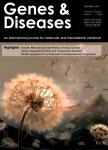Molecular and cellular pathophysiology of circulating cardiomyocyte-specific cell free DNA (cfDNA): Biomarkers of heart failure and potential therapeutic targets
作者机构:Raja Peary Mohan College Integrated Biological Research Facility(RIBRF)Raja Peary Mohan CollegeUttarparaHooghlyWest Bengal 712258India
出 版 物:《Genes & Diseases》 (基因与疾病(英文))
年 卷 期:2023年第10卷第3期
页 面:948-959页
核心收录:
学科分类:0710[理学-生物学] 1002[医学-临床医学] 10[医学]
基 金:funded by the SCIENCE&ENGINEERING RESEARCH BOARD(SERB)(No.-ECR/2018/001901 Dated 19.09.2019) Department of Science and Technology,Government of India We also gratefully acknowledge the BOOST funding(No.-1086/BT(Estt)/1P-03/2018 Dated 24.10.2019)by Department of Science&Technology and Biotechnology,Government of West Bengal,India.
主 题:Apoptosis Circulating DNA Fibrosis Heart failure Inflammation Nucleic acid receptor
摘 要:Pathological cardiac damage during heart failure is associated with cell death and damage associated molecular patterns (DAMPs) release which triggers a viscous cycle of sterile inflammation to mediate maladaptive cardiac tissue remodelling during the progression to heart failure. DAMPs like cytokines, chemokines, and nuclear or mitochondrial genomic fragments are released in the pathological myocardium. Interestingly, circulating or cytosolic DNA fragments can play a role in the disease by interaction with nucleic acid sensors expressed in cardiomyocyte and non-myocyte neighbouring cells. The circulating cell free DNA (cfDNA) fragments have been clinically reported as markers for various diseases including cardiovascular pathophysiology. Such cfDNA within the DAMP pool can mediate intra- and inter-cellular signalling cascade to upregulate transcriptional expression of inflammatory mediators and trigger oxidative stress within cells. The cellular role of such genomic equivalents varying with chronic or acute stress might be correlated with the cell death forms encountered in myocardium during disease progression. Thus, cfDNA can be phenotypically correlated as a critical player towards upregulation of pathological processes like interstitial fibrosis, cardiomyocyte contractile dysfunction and cell death. Herein, we review the association of cfDNA with heart failure and analyse their potential usage as novel and effective therapeutic targets towards augmentation of cardiac function.



